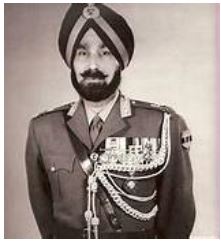HARBAKHSH SINGH, GENERAL

General Harbakhsh Singh (1.10.1913 – 14.11.1999) was born in village Badrukhan (distt Sangrur). When he grew up, he joined the Indian Military Academy in 1933. He was commissioned on 15 July, 1935; and, he started his career with a year’s post-commission attachment with the 2nd battalion, Argyll and Sutherland Highlanders at Rawalpindi.
During Second World War, he fought against the Japanese Army. During a battle at Kuantan on 5 January 1942, he (then Capt. Harbaksh Singh) was seriously injured. He was taken prisoner of war as Singapore fell to the Japanese Army. He was repatriated in September 1945 after the war was over.
In 1947, during battle of Kashmir he was posted as Deputy Commander at the headquarters of 161 Infantry Brigade. He conducted the main battle against the raiders at Shelatang Bridge on 7 November 1947. This decisive battle, involving 1st battalion Sikh Regiment and 4th battalion Kumaon Regiment, proved to be a turning point in the war. On 12 December 1947, he proceeded to Uri and took over the command of the battalion voluntarily, dropping a star from his rank. He brought back the battalion to Srinagar and began to rehabilitate it. However, even before the rehabilitation was complete, the battalion was called out to fight the enemy who had occupied Handwara. In 1948, he was promoted to the rank of Brigadier. He took over the command of 163 Infantry Brigade and began to advance to Tithawal; finally Tithawal was captured. As a reward for his bravery, he was awarded a Vir Chakra.
After the Kashmir operations, he went on to serve as the Deputy Commandant of the Indian Military Academy at the western command headquarters, director of infantry at the Army headquarters. In 1957 attended a course at the Imperial Defence College (now Royal College of Defence Studies), UK. In January 1959, he became the first foreign officer to go on
attachment with German Army’s first division to be raised after their disbandment at the end of World War II.
After his return to India, he was appointed as the General Officer Commanding of the 27 Infantry Division, and later as the GOC of 5 Infantry Division. From July 1961 to October 1962, he was the Chief of Staff at the Western Command headquarters. In November 1964, he was appointed as Army Commander and took over as the General Officer Commanding-in-Chief (GOC-in-C) of the Western Command (whose area of responsibility spanned from Ladakh to Punjab). On 6th of September 1965, Indo-Pak War began. During the first three days Pakistan had an upper hand. On 9th of September Indian Army Chief J.M. Chowdhry asked him to leave Amritsar border and take position at Beas river. Harbakhsh Singh took the orders from his boss, but his conscious did not allow him to abandon Amritsar. He gave a great fight to Pakistani Army and saved Amritsar and three more districts. Lal Bahadur Shahsti, the Prime Minister of India, was greatly impressed by his action.
He remained as the General-Officer-Commanding-in-Chief of the Western Army Command from 1964 to 1969, the General retired in September 1969. Captain Amarinder Singh (later Chief Minister of Punjab) of Patiala served him as his ADC.